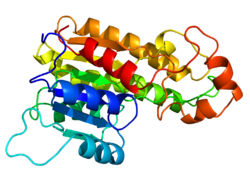Overview
The DHRS7B gene is located on the positive strand of chromosome 17, beginning at position 21030258 and ending at position 21094836 (64579 bp). [10] DHRS7B contains seven exons with no predicted alternate splice forms, resulting in an 1841 bp mRNA product. [10] [11]
Upstream of DHRS7B on the negative strand of chromosome 17p11.2 are the genes Coiled-coil domain containing 144 family, N-terminal-like (CCDC144NL) and Ubiquitin specific peptidase 22 (USP22). [12] Downstream of DHSRS7B on the negative strand of chromosome 17p11.2 is the gene Transmembrane protein 11 (TMEM11), and on the positive strand is the gene Mitogen-activated protein kinase, kinase 3 (MAP2K3). [12]
Gene expression
Microarray and EST data indicates that the DHRS7B gene is highly expressed in the testes, thyroid, kidneys, and adipose tissues. There is moderate expression in the brain, pancreas, mammary glands, and ovaries. Finally, there is little expression in spleen, thymus, tonsils, bone marrow, and bladder. [13] [14]





